GRIN Fiber Optic Collimators/Couplers, Single Mode Fiber
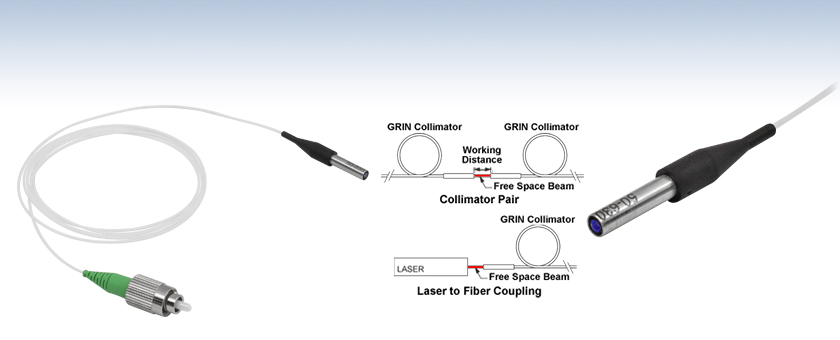
- GRIN Lens Couples and Collimates Light
- AR-Coated Lens Surface
- Alignment Wavelength: 630, 780, 850, 980, 1064, 1310, or 1550 nm
50-850-APC
GRIN Lens is Housed Inside a
Ø3.4 mm Stainless Steel Housing

Please Wait
| Common Specifications | |
|---|---|
| Collimator Pair Performance | |
| Working Distance | 15 mm ± 5 mm |
| Individual Performance | |
| Beam Diameter (at Working Distance) |
≤0.5 mm FWHM |
| Beam Divergence | ≤0.25° |
| General | |
| Clear Aperture | Ø1.8 mm |
| Optical Power | 300 mW (Max) |
| GRIN Lens Material | Oxide Glass |
| Tensile Load | 5 N (Max) |
| Fiber Jacket | Ø900 µm Tubing (White) |
| Operating Temperature | 0 to 60 °C |
| Storage Temperature | -40 to 85 °C |
Features
- Couple and Collimate Light In or Out of a Fiber
- Lens Surface is AR Coated for 630, 780, 850, 980, 1064, 1310, or 1550 nm
- Ø1.8 mm Clear Aperture
- 300 mW Maximum Power
- Pigtailed to SM Fiber with an Optional FC/PC or FC/APC Connector
Thorlabs offers pigtailed fiber collimators that use gradient-index (GRIN) lenses. These GRIN collimators feature a Ø1.8 mm clear aperture and are coupled to standard single mode fiber. They are designed to be used in pairs, with a free-space beam between the lenses, and can also be used individually. We offer models aligned at 630 nm, 780 nm, 850 nm, 980 nm, 1064 nm, 1310 nm, or 1550 nm and with a choice of an unterminated fiber end, a 2.0 mm narrow key FC/PC connector, or a 2.0 mm narrow key FC/APC connector.
For Thorlabs' complete selection of fiber collimators, please see the Collimator Guide tab. In particular, we offer multimode pigtailed GRIN collimators and loose GRIN lenses, which can be paired with pigtailed ferrules that have terminated or unterminated fiber ends to create a custom collimator similar to those sold on this page.
Free-Space Coupling
When using GRIN collimators to couple a free-space beam into a fiber, precise alignment is needed for good coupling efficiency. We recommend using a kinematic tip and tilt mount and lens tube adapter, paired with an XYZ adjustable platform (such as our POLARIS-K05T6, SM05PT, sold below, and MT3), or our 6-axis kinematic mount paired with a lens tube adapter (K6XS and SM1PT, sold below).

Click to Enlarge
GRIN Collimator Pair with Free-Space Beam, Mounted with POLARIS-K05T6 Mirror Mounts and SM05PT Adapters (Sold Below)
Collimator Pair with Free-Space Beam
Our GRIN pigtailed collimators are designed to be used in pairs, with a free-space beam between the lenses (see photo to the left). This free-space beam can be manipulated with many types of optics prior to entering the second lens. The collimators should be placed with a spacing of 15 ± 5 mm (working distance) between the front lens surfaces for maximum coupling efficiency. When used within the specified working distance and mounted on tip-tilt mounts as described in Free-Space Coupling, above, typical insertion losses of 0.2 - 2.0 dB are possible, depending on model (see the Pair Insertion Loss spec for each wavelength range, below).
Click on the Pair Performance icon in the tables below to view experimentally measured coupling efficiency data for each collimator pair as a function of the spacing between the collimators. Although the optimal working distance will slightly deviate for any two individual collimators due to small manufacturing variations, these slight deviations do not significantly affect pair or individual performance. This is evidenced by the data given below, which was taken with randomly selected collimators. To achieve the best possible coupling, we recommend mounting both collimators in kinematic adjustable mounts, such as the POLARIS-K05T6 with SM05PT, sold below, for final alignment. All specifications, including beam diameter, beam distance, and pair insertion loss, are guaranteed at a working distance of 20 mm for any given collimator pair.
Thorlabs' FiberBench, which can accommodate pre-aligned FiberPort collimators and allows modular optical components to be placed in the beam path, is offered for modular fiber/free-space setups.
Loose GRIN Lenses
Thorlabs also offers single wavelength or broadband loose GRIN lenses for use with either a single wavelength or broadband light source. These GRIN lenses can be paired with our single mode pigtailed ferrules, which are offered with or without connectors. In contrast to the products sold on this page, these options allow the combination of GRIN lens and pigtailed ferrule to be chosen individually, satisfying a wide range of experimental requirements.
Insights into Best Lab Practices
Scroll down to read about a practice we follow when setting up lab equipment.
- Align Fiber Collimators to Create Free Space Between Fibers
Click here for more insights into lab practices and equipment.
Align Fiber Collimators to Create Free Space Between Fibers
Two collimators, inserted into a fiber optic setup, provide free-space access to the beam. The first collimator accepts the highly diverging light from the first fiber and outputs a free-space beam, which propagates with an approximately constant diameter to the second collimator. The second collimator accepts the free-space beam and couples that light into the second fiber. Some collimation packages, including the pair used in this demonstration, are designed for use with optical fibers and mate directly to fiber connectors.
Ideally, 100% of the light emitted by the first fiber would be coupled into the second fiber, but some light will always be lost due to reflections, scattering, absorption, and misalignment. Misalignment, typically the largest source of loss, can be minimized using the alignment and stabilization techniques described in this video.
In this demonstration, the first fiber is single mode. The optical power incident on the second collimator, as well as the power output by the second fiber, are measured. When the second fiber is multimode with a 50 µm diameter core, alignment resulted in 91% of the power incident on the second collimator being measured at the fiber output. This value was 86% when the second fiber is single mode. Some differences in collimator designs, and their effects on the characteristics of the collimated beams, are also discussed.
If you would like more information about tips, tricks, and other methods we often use in the lab, we recommend our other Video Insights. In addition, our webinars provide practical and theoretical introductions to our different products.
| Products Featured During Demonstration | ||||
|---|---|---|---|---|
| Fiber-Coupled Laser | Kinematic Mounts | Fiber Adapter Cap (for Power Sensor) |
Single Mode Patch Cable (FC/PC) | Fiber Cable Storage Reels |
| Triplet Fiber Optic Collimators | Power Sensor | Power Meter | Hybrid Single Mode Patch Cable | 2" Posts |
| Adapter (Mount-to-Collimator) |
SM1 Thread Adapter (for Power Sensor) |
Fiber Connector Cleaner | Step-Index Multimode Patch Cable | Ø1/2" Post Holders |
Date of Last Edit: April 21, 2021
| Posted Comments: | |
user
(posted 2024-01-23 10:39:10.193) Hi, what's the error bar on the 0.5 mm FWHM beam width? I noticed that there wasn't an error bar and so it appeared to be a rough estimate. So after I purchased 4x 50-1550A-APC, I used a knife edge scan to measure the beam waist and the average I measured for the 4 is a FWHM of 0.22 mm +/-0.01 mm. I can share my methods in more detail if you want to contact me via email. 0.2 is 40% of 0.5 which can be a significant difference when choosing other components for a more complicated optical system (like I'm doing) so I encourage you to more precisely spec the output beam width on your website. jdelia
(posted 2024-01-30 02:04:42.0) Thank you for contacting Thorlabs. After looking into your inquiry, we determined that the 0.5 mm beam diameter specification you mentioned is actually an error on the website. The value should actually be ≤0.5 mm indicating a maximum value of 0.5 mm, not an expected value of 0.5 mm. We thank you for bringing this to our attention and apologize for any inconvenience this misunderstanding may have caused. We are currently working on updating the website to reflect the correct specification. Ramprakash Ananthapadmanaban
(posted 2023-12-06 06:43:18.16) Hi, I need to record the intensities of multiple focusing laser beams (WL=532 nm, a diode laser). These beams are closely spaced, so I can't use PDA36A2 detectors to catch those focused beams. Instead, at first, I planned to use fibre optics. Since the maximum core diameter of those is 1.5 mm, I fear that my focusing beam diameter is greater than the sensing area of the fibre optics. Thus, I plan to buy a collimator (not sure it's a good idea) so the other end of the fibre optics can be connected to my photodetector. Still, the diameter of the outer casing of the collimator will determine its usage to my needs. My question is, what would be the suitable collimator with minimum outer casing diameter for my application? cdolbashian
(posted 2023-12-13 03:09:35.0) Thank you for reaching out to us with this application inquiry. I have contacted you directly in order to find the potential best solution to your inquiry. jangbeom lee
(posted 2022-08-16 13:05:37.91) Is Grin Lens of 50-1550A-APC GRIN2315A?
The 50-1550A-APC attempts to focus laser light in free space. Is there a working distance? What is your advice? jgreschler
(posted 2022-08-30 08:03:09.0) Thank you for reaching out to Thorlabs. The collimators on this page produce a beam of 0.5mm FWHM, with a beam divergence of 0.25 degrees. The working distance is 15mm with a tolerance of 5mm. More specifications can be found at the top of the page in the "common specifications" chart. Sy Ahn
(posted 2022-05-02 13:37:31.44) We are considering to use GRIN2313A or 50-1310A-APC as an alignment system. But we're not sure whether if we can make the spot size of beam under 200 um(for our application).
So, could you offer me some data sheet of lens in 50-1310A-APC model so that we can have a simulation of it?
And for focusing the laser beam(1392nm respectively) under 200 with GRIN lenses, can you give us any advice? jgreschler
(posted 2022-05-02 09:41:46.0) Thank you for reaching out to Thorlabs. The output beam diameter is one of the "common specifications" listed at the top of the product page https://www.thorlabs.us/newgrouppage9.cfm?objectgroup_id=1340&pn=50-1310A-APC. For all of the fibers on that page the beam diameter is specified to 0.5mm at the listed working distance. If you require it to be a smaller value you will need to incorporate a ratio <1 beam expander in your system. Nikola Dordevic
(posted 2021-02-19 08:59:07.283) How should be output of the GRIN collimator be simulated in ZEMAX? Do you have the file already prepared?
I am designing an optical using the output of 850nm centered GRIN collimator as a primary source.
Thanks in advance for your help.
Best,
Nikola YLohia
(posted 2021-03-05 09:59:27.0) Thank you for contacting Thorlabs. Unfortunately, we don't have a Zemax model to share for this GRIN collimator. The lens has a .25 pitch at the nominal wavelength (850nm). It is likely very close to the GRIN2908, which we do have a Zemax file for: https://www.thorlabs.com/thorproduct.cfm?partnumber=GRIN29084 Alberto Carrasco
(posted 2019-07-17 10:31:27.97) I need to couple a 5-mm collimated free-space beam into a single-mode fiber. Could I use this with a lens before to make the beam smaller in order to enter the grin lens 1.8 clear aperture? Thank you. YLohia
(posted 2019-07-19 08:49:05.0) Thank you for contacting Thorlabs. The input beam needs to be collimated (not focused) when going into the GRIN lens for optimal coupling. You will have to use a beam expander in reverse in order to accomplish that : https://www.thorlabs.com/navigation.cfm?guide_id=2023 Christoph Zech
(posted 2019-03-29 08:50:45.96) Hello,
I was wondering whether you could provide some data about the manufacturing tolerances of these collimators?
Especially about the concentricity of the lens inside the alignment ferrule and the maximum latteral and angular deviation between the fiber and the lens.
Regards,
Chris YLohia
(posted 2019-04-03 11:24:58.0) Hello Chris, thank you for contacting Thorlabs. I have reached out to you directly to discuss how such tolerances affect your specific application. alexey.kokhanovskiy
(posted 2018-09-12 12:46:59.113) Dear Sir,
Is it possible to make GRIN fiber collimator 50-1064 with PM980 fiber?
With respect,
Alexey Kokhanovskiy nbayconich
(posted 2018-09-19 02:28:44.0) Thank you for contacting Thorlabs. We can provide this as a custom request. I will contact you directly to discuss our custom capabilities. muhammad.1983
(posted 2018-05-29 04:58:39.597) Dear Sir:
I have been trying to collimate the 1310nm fiber laser between two Single Mode Pigtailed GRIN Fiber Collimators, 1310 nm (Part # 50-1310A-APC). I have mounted the two collimators on POLARIS-K05T6 Mounts with SM05PT Adapters. but i couldn't achieve the collimation still.
What am trying to achieve:
I have connected one collimator with 1310nm source and beam from this collimator is entering into right angle prism and after reflection this beam is entering into second collimator, the fiber of is this collimator is connected to power meter to check power coupling.
Can you please share a video of collimation (with power meter connected to other collimator) for illustration purposes as it will give me an idea whether am working in right or wrong direction.
best regards, llamb
(posted 2018-06-12 08:50:16.0) Hello, thank you for contacting Thorlabs. While we do not have a video for collimation practices, I do have some troubleshooting questions and tips for your setup. Using an IR viewing card will be very helpful for alignment, if you do not have one already. Many of our fiber-coupled benchtop sources are also designed for FC/PC connectors, not FC/APC. Which do you have specifically? Also, how well collimated is your beam exiting the first GRIN lens? Could you please send a picture of your setup? I have reached out to you directly for further troubleshooting as well. alex
(posted 2018-04-23 10:35:39.837) Is Thorlabs able to offer grin lens assemblies without the metal housing and strain relief boot? YLohia
(posted 2018-04-23 03:11:29.0) Hello, thank you for contacting Thorlabs. Such GRIN lens assemblies can be constructed using our stock parts available on the website. You can find out single mode pigtail ferrules on this (https://www.thorlabs.com/newgrouppage9.cfm?objectgroup_id=6321 / https://www.thorlabs.com/newgrouppage9.cfm?objectgroup_id=6336) page. You can then choose your GRIN lens (https://www.thorlabs.com/newgrouppage9.cfm?objectgroup_id=1209) and mate it with the single mode pigtail ferrules using the mating sleeve that can be found on the same page. I will reach out to you directly to ensure that these stock components work for your application. dlaughlin
(posted 2017-07-18 12:14:53.78) Can 50-630-APC (and -FC) be specified with PM fiber (4/125u)? If so, what is the time to shipment? tfrisch
(posted 2017-07-27 01:49:27.0) Hello, thank you for contacting Thorlabs. I will reach out to you about the details for a quote. m.zimmermann
(posted 2013-08-16 13:19:07.893) Dear Sir or Madam,
would it be possible to generate a GRIN single mode collimator for 532 nm? Fiber length 3m. Connector FC-PC. The CFS2-532-FC is to large for my application.
If yes please send me the price for this product. Thanks a lot!
Best regards,
Maik tcohen
(posted 2012-07-19 16:02:00.0) Response from Tim at Thorlabs: Thank you for your interest in our pigtailed collimators! Typically, we are able to offer more cost effective solutions with our other custom aligned collimators such as our aspheric collimation package and our pigtailed aspheric collimators (http://www.thorlabs.com/NewGroupPage9.cfm?ObjectGroup_ID=3212). Of course this will be subject to your requirements. I will contact you to discuss this with you directly. coryg
(posted 2012-07-19 13:57:01.0) Would you be able to send me a quote on a pigtailed GRIN fiber collimator designed for the 910nm wavelength with an 8um core in the fiber? jjurado
(posted 2011-03-01 16:46:00.0) Response from Javier at Thorlabs to cf102: Thank you for contacting us with your request. The excess loss, defined here as the fractional overlap between the circular Gaussian profiles of the ligt from the transmitting fiber and that of the modefield diameter of the receiving fiber, depends upon three main parameters: (1) offset between the longitudinal axes of the lenses, (2) separation between faces of the lenses, and (3) angular tilt between the axes of the lenses. Authors Robert Gilsdorf and Joseph Palais (full reference below) published theoretical calculations as well as measurements using two GRIN lenses in a fiber-to-fiber coupling system (4.8 mm long, 1.8 mm diam., 0.25 pitch at 1300 nm). Their results for the three aforementioned parameters are summarized as follows:
(1) For an offset of 100 um between the lens axes, excess loss is ~1.5 dB (85% efficiency).
(2) A separation of 100 mm resulted in a loss of 3 dB (70% efficiency).
(3) A tilt of 0.2 degrees resulted in a 7 dB loss (45% efficiency).
Keep in mind that these values do not take into account other loss mechanisms due to aberrations, absorption, scattering, etc. in the system.
It may be recommendable to use a fiberbench system with fiberports instead of the cage system.I will contact you directly to get more information about your experiment.
Reference:
Robert W. Gilsdorf and Joseph C. Palais, "Single-mode fiber coupling efficiency with graded-index rod lenses," Appl. Opt. 33, 3440-3445 (1994) cf102
(posted 2011-03-01 13:03:10.0) Hi, would you expect good coupling efficiency between two of these pigtailed GRIN collimators when seperated by ~20cm and mounted in a 30mm kinematic cage mount and a cage system. What sort of coupling efficiency would you expect. Using a PAF-X-11-C at one end would probably give much higher coupling efficiency. What is your opinion on this. Thanks, C. Greg
(posted 2011-01-13 11:24:35.0) A response from Greg at Thorlabs to supratimece and muszal: Working distance is the distance apart that two collimators should be placed when used as a pair. The distance to the beam waist is thus half of the working distance. So collimating and coupling with these products is definitely possible. muszal
(posted 2011-01-02 22:09:12.0) Dear Sir or Madame,
what is the working distance in case of the pigtailed collimator ?
Collimator couples the free space beam to the fiber isnt it ?
so the distance collimator lens - laser doesnt matters, isnt it ?
Jan Muszalski
Jan Muszalski supratimece
(posted 2010-12-30 01:48:27.0) What is the meaning of optimized working distance? We want to collimate light on a reflecting surface and also want to collect the reflected light using the same collimator. Is it possible with this GRIN lens pigtailed collimator? Has "Optimized working distance" anything to do in this application? Tyler
(posted 2008-04-09 13:35:13.0) Response from Tyler at Thorlabs to floridia: An applications engineer will be contacting you to discuss your application and provide you with any information that we might have about how our product will work in that application. At this time I do not have the equations that you requested. If they become available in the future I will post them on this website. If you come across information that you would like to contribute to the presentation of this website, please consider using this feedback form as a means to submit a contribution. Thank you for your feedback submission. floridia
(posted 2008-04-03 07:41:19.0) Dear Sir,
I would like to have information about aspheric and grin lenses collimators. Does they have same transversal and angular acceptance? Could you provide me with formulas that gives coupling efficiency as a function of distance between to colimmators (axial distance) and off-axis distance? also coupling efficiency as a function of angle between to collimators. I´m interested in coupling light from one SM fiber to the other in a moving machine. There exists some collimator with 1mm tolerance (measured 3dB below the peak)?
Thanks,
Claudio Floridia borin
(posted 2008-02-19 12:43:54.0) I would like to know what is the lateral tolerances beetween two coupled collimators once one of them will vibrate. Thanks and regards,
Flavio technicalmarketing
(posted 2007-11-08 15:23:39.0) Unfortunately, we dont offer a pigtailed grin collimator for use at 1060 nm with 50 um multimode fiber. Thorlabs does offer a single mode pigtailed solution for collimation of 1064nm light: CFS2-1064-FC, CFS5-1064-FC, CFS11-1064-FC, and CFS18-1064-FC. For collimation over a range of wavelengths try our adjustable collimators: The PAF series of FiberPort and the CFC series Snap-On collimation packages. liuvic6
(posted 2007-11-08 03:56:38.0) Is there a pigtailed grin collimator with 50 um multimode fiber, and used for 1060nm? |
Fiber Collimator Selection Guide
Click on the collimator type or photo to view more information about each type of collimator.
| Type | Description | |
|---|---|---|
| Fixed FC, APC, or SMA Fiber Collimators | 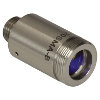 |
These fiber collimation packages are pre-aligned to collimate light from an FC/PC-, FC/APC-, or SMA-terminated fiber. Each collimation package is factory aligned to provide diffraction-limited performance for wavelengths ranging from 405 nm to 4.55 µm. Although it is possible to use the collimator at detuned wavelengths, they will only perform optimally at the design wavelength due to chromatic aberration, which causes the effective focal length of the aspheric lens to have a wavelength dependence. |
| Air-Spaced Doublet, Large Beam Collimators | 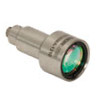 |
For large beam diameters (Ø5.3 - Ø8.5 mm), Thorlabs offers FC/APC, FC/PC, and SMA air-spaced doublet collimators. These collimation packages are pre-aligned at the factory to collimate a laser beam propagating from the tip of an FC or SMA-terminated fiber and provide diffraction-limited performance at the design wavelength. |
| Triplet Collimators | 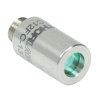 |
Thorlabs' High Quality Triplet Fiber Collimation packages use air-spaced triplet lenses that offer superior beam quality performance when compared to aspheric lens collimators. The benefits of the low-aberration triplet design include an M2 term closer to 1 (Gaussian), less divergence, and less wavefront error. |
| Achromatic Collimators for Multimode Fiber | 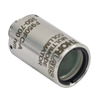 |
Thorlabs' High-NA Achromatic Collimators pair a meniscus lens with an achromatic doublet for high performance across the visible to near-infrared spectrum with low spherical aberration. Designed for use with high-NA multimode fiber, these collimators are ideal for Optogenetics and Fiber Photometry applications. |
| Reflective Collimators |  |
Thorlabs' metallic-coated Reflective Collimators are based on a 90° off-axis parabolic mirror. Mirrors, unlike lenses, have a focal length that remains constant over a broad wavelength range. Due to this intrinsic property, a parabolic mirror collimator does not need to be adjusted to accommodate various wavelengths of light, making them ideal for use with polychromatic light. Our fixed reflective collimators are recommended for collimating single and multimode fiber and coupling into multimode fiber. These collimators are available with UV-enhanced aluminum or protected silver reflective coatings and with FC/PC, FC/APC, or SMA connector compatibility. |
| Compact Reflective Collimators | 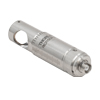 |
Thorlabs' Compact Reflective Collimators incorporate a 90° off-axis parabolic mirror with a protected silver coating. Because the focal length is independent of wavelength for an off-axis parabolic mirror, they are ideal for use with polychromatic light. Our fixed reflective collimators are recommended for collimating single and multimode fiber and coupling into multimode fiber. These collimators are directly compatible with our 16 mm cage system. They are available with FC/PC, FC/APC, or SMA connector inputs. |
| Adjustable Reflective Collimators | 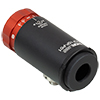 |
Thorlabs' Adjustable Focus Reflective Collimators are based on a 90° off-axis parabolic (OAP) mirror with a protected silver coating. The adjustable fiber-to-OAP distance, combined with the OAP having a constant focal length across wavelengths, makes these collimators ideal for optimizing collimation or coupling of polychromatic light with single mode or multimode fiber. These adjustable collimators have a 15 mm reflected focal length and are available with FC/PC, FC/APC, or SMA connectors. |
| FiberPorts | 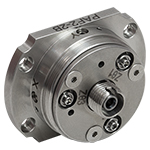 |
These compact, ultra-stable FiberPort micropositioners provide an easy-to-use, stable platform for coupling light into and out of FC/PC, FC/APC, or SMA terminated optical fibers. It can be used with single mode, multimode, or PM fibers and can be mounted onto a post, stage, platform, or laser. The built-in aspheric or achromatic lens is available with five different AR coatings and has five degrees of alignment adjustment (3 translational and 2 pitch). The compact size and long-term alignment stability make the FiberPort an ideal solution for fiber coupling, collimation, or incorporation into OEM systems. |
| Adjustable Fiber Collimators |  |
These collimators are designed to connect onto the end of an FC/PC, FC/APC, or SMA connector and contain an AR-coated aspheric lens. The distance between the aspheric lens and the tip of the fiber can be adjusted to compensate for focal length changes or to recollimate the beam at the wavelength and distance of interest. |
| Achromatic Fiber Collimators with Adjustable Focus |  |
Thorlabs' Achromatic Fiber Collimators with Adjustable Focus are designed with an effective focal length (EFL) of 20 mm, 40 mm, or 80 mm, have optical elements broadband AR coated for one of three wavelength ranges, and are available with FC/PC, FC/APC, or SMA905 connectors. A four-element, air-spaced lens design produces superior beam quality (M2 close to 1) and less wavefront error when compared to aspheric lens collimators. These collimators can be used for free-space coupling into a fiber, collimation of output from a fiber, or in pairs for collimator-to-collimator coupling over long distances, which allows the beam to be manipulated prior to entering the second collimator. |
| Zoom Fiber Collimators | 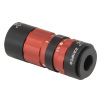 |
These collimators provide a variable focal length between 6 and 18 mm, while maintaining the collimation of the beam. As a result, the size of the beam can be changed without altering the collimation. This universal device saves time previously spent searching for the best suited fixed fiber collimator and has a very broad range of applications. They are offered with FC/PC, FC/APC, or SMA905 connectors with three different antireflection wavelength ranges to choose from. |
| Single Mode Pigtailed Collimators | 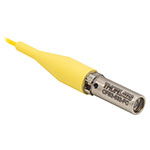 |
Our single mode pigtailed collimators come with one meter of fiber, consist of an AR-coated aspheric lens pre-aligned with respect to a fiber, and are collimated at one of eight wavelengths: 532 nm, 633 nm, 780 nm, 850 nm, 1030 nm, 1064 nm, 1310 nm, or 1550 nm. Although it is possible to use the collimator at any wavelength within the coating range, the coupling loss will increase as the wavelength is detuned from the design wavelength. |
| Polarization Maintaining Pigtailed Collimators | 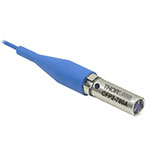 |
Our polarization maintaining pigtailed collimators come with one meter of fiber, consist of an AR-coated aspheric lens pre-aligned with respect to a fiber, and are collimated at one of five wavelengths: 633 nm, 780 nm, 980 nm, 1064 nm, or 1550 nm. Custom wavelengths and connectors are available as well. A line is engraved along the outside of the housing that is parallel to the fast axis. As such, it can be used as a reference when polarized light is launched accordingly. Although it is possible to use the collimator at any wavelength within the coating range, the coupling loss will increase as the wavelength is detuned from the design wavelength. |
| GRIN Fiber Collimators | 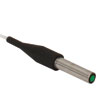 |
Thorlabs offers gradient index (GRIN) fiber collimators that are aligned at a variety of wavelengths from 630 to 1550 nm and have either FC terminated, APC terminated, or unterminated fibers. Our GRIN collimators feature a Ø1.8 mm clear aperture, are AR-coated to ensure low back reflection into the fiber, and are coupled to standard single mode or graded-index multimode fibers. |
| GRIN Lenses | 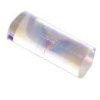 |
These graded-index (GRIN) lenses are AR coated for applications at 630, 830, 1060, 1300, or 1560 nm that require light to propagate through one fiber, then through a free-space optical system, and finally back into another fiber. They are also useful for coupling light from laser diodes into fibers, coupling the output of a fiber into a detector, or collimating laser light. Our GRIN lenses are designed to be used with our Pigtailed Glass Ferrules and GRIN/Ferrule sleeves. |

| Item # | Connector | Wavelength Range |
Alignment Wavelength |
Fiber | Pair Insertion Lossa,b |
Pair Performance |
Insertion Lossa,c |
Return Loss (Min)a,c |
|---|---|---|---|---|---|---|---|---|
| 50-780 | Scissor Cut | 760 - 800 nm | 780 nm | 1 m of HI780 |
0.50 dB | (Raw Data) |
<0.1 dB | 55 dB |
| 50-780-FC | FC/PC | |||||||
| 50-780-APC | FC/APC |

| Item # | Connector | Wavelength Range |
Alignment Wavelength |
Fiber | Pair Insertion Lossa,b |
Pair Performance |
Insertion Lossa,c |
Return Loss (Min)a,c |
|---|---|---|---|---|---|---|---|---|
| 50-850 | Scissor Cut | 830 - 870 nm | 850 nm | 1 m of HI780 |
<0.35 dB | (Raw Data) |
<0.1 dB | 55 dB |
| 50-850-FC | FC/PC | |||||||
| 50-850-APC | FC/APC |

| Item # | External Threading | Compatible Component Size | Length | |
|---|---|---|---|---|
| Diameter | Length | |||
| SM05PT | SM05 (0.535"-40) | 3.5 mm | ≥0.26" (6.6 mm) | 0.50" (12.7 mm) |
| SM1PT | SM1 (1.035"-40) | |||
- External SM05 (0.535"-40) or SM1 (1.035"-40) Threads
- Ø0.14" (Ø3.5 mm) Center Hole
- Nylon-Tipped Setscrew Secures GRIN Collimator
These adapters are designed to mount Thorlabs' GRIN Lens Fiber Collimators in SM05- or SM1-compatible mounts, lens tubes, and cage components. The adapters' design ensures that the GRIN lens is aligned with the optical axis when mounted into a lens tube. A 1/16" (1.5 mm) hex, nylon-tipped setscrew is used to press the GRIN lens fiber collimator against the two lines of contact created by the double-bored mounting hole. Additionally, each adapter has holes on opposing sides of the central bore for use with a spanner wrench. The SM05PT is compatible with the SPW908 spanner wrench while the SM1PT is compatible with the SPW801 and SPW909 spanner wrenches.

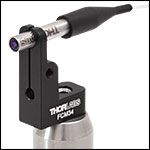
Click to Enlarge
FCM34 Ferrule Clamp with a GRIN Collimator
- Compact Flexure Clamp for Ø3.4 mm GRIN Collimator Housing
- 8-32 (M4) Tapped Mounting Hole
- Compatible with Ø1/2" Optical Posts
This Post-Mountable Ferrule Clamp allows GRIN Collimators to be mounted securely and compactly within an experimental setup. The collimator is clamped into the flexure mount using a 5/64" (2 mm) hex key. An 8-32 (M4) tapped hole on the bottom of the mount provides compatibility with our Ø1/2" optical posts.
 Products Home
Products Home












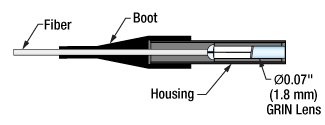

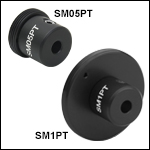
 Zoom
Zoom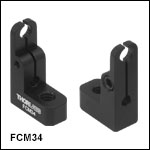
 Single Mode GRIN Collimators
Single Mode GRIN Collimators